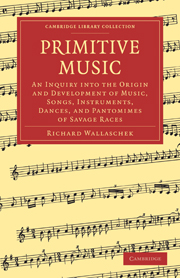 Primitive Music
Primitive Music Book contents
- Frontmatter
- PREFACE
- Contents
- CHAPTER I GENERAL CHARACTER OF THE MUSIC OF PRIMITIVE PEOPLE
- CHAPTER II SINGERS AND COMPOSERS IN PRIMITIVE TIMES
- CHAPTER III INSTRUMENTS
- CHAPTER IV THE BASIS OF OUR MUSICAL SYSTEM
- CHAPTER V PHYSICAL AND PSYCHICAL INFLUENCE OF MUSIC
- CHAPTER VI TEXT AND MUSIC
- CHAPTER VII DANCE AND MUSIC
- CHAPTER VIII PRIMITIVE DRAMA AND PANTOMIME
- CHAPTER IX ORIGIN OF MUSIC
- CHAPTER X HEREDITY AND DEVELOPMENT
- Summary
- List of quoted Authorities
- Index
- Plate section
CHAPTER VII - DANCE AND MUSIC
Published online by Cambridge University Press: 29 August 2010
- Frontmatter
- PREFACE
- Contents
- CHAPTER I GENERAL CHARACTER OF THE MUSIC OF PRIMITIVE PEOPLE
- CHAPTER II SINGERS AND COMPOSERS IN PRIMITIVE TIMES
- CHAPTER III INSTRUMENTS
- CHAPTER IV THE BASIS OF OUR MUSICAL SYSTEM
- CHAPTER V PHYSICAL AND PSYCHICAL INFLUENCE OF MUSIC
- CHAPTER VI TEXT AND MUSIC
- CHAPTER VII DANCE AND MUSIC
- CHAPTER VIII PRIMITIVE DRAMA AND PANTOMIME
- CHAPTER IX ORIGIN OF MUSIC
- CHAPTER X HEREDITY AND DEVELOPMENT
- Summary
- List of quoted Authorities
- Index
- Plate section
Summary
It is scarcely possible to speak of the beginning of music without at the same time thinking of the dances with which it was so intimately connected. This is, moreover, no accidental connection that can under certain circumstances be omitted as in the case of poetry and music; it is more than a mere connection, it is a unified organism which later led to an independent musical branch, so unified that it is neither possible to treat of the subject of primitive dance without primitive music, nor to make it even probable by means of ethnological examples that they ever were separated. In regard to this, Richard Wagner was undoubtedly on the right track—as he always was when following the bent of his genius—when he traced the original form of music to the dance. But I believe that he erred in his further investigations of this idea in placing the art of poetry third in the order of original art-forms (he even suggested the spelling “Tichtkunst” instead “Dichtkunst” for the sake of analogy with “Tanzkunst” and “Tonkunst”). Later arisen, and in spite of emotional influences always depending upon our intellect, poetry preserved an independent position, which afforded all sorts of connecting links but admitted of no organic unity. So in primitive culture there existed not only poetry without music (which in the case of the dance would be quite inconceivable) but also vocal music without poetry, without even words, while the recitative and “speech-song,” which was a hybrid of comparatively late date, had been proved to be incapable of further development.
- Type
- Chapter
- Information
- Primitive MusicAn Inquiry into the Origin and Development of Music, Songs, Instruments, Dances, and Pantomimes of Savage Races, pp. 187 - 213Publisher: Cambridge University PressPrint publication year: 2009First published in: 1893


